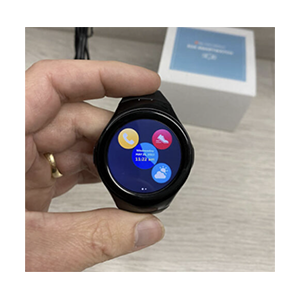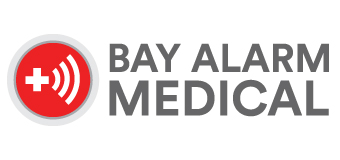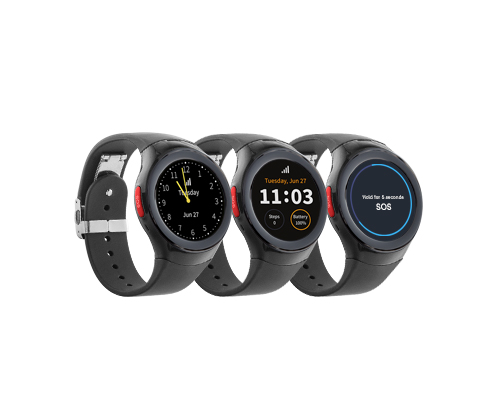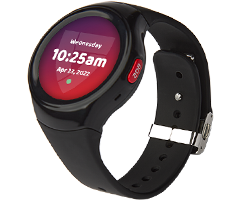MedicalAlertBuyersGuide.org is an independent review site. We may earn compensation from the providers below. Learn More

Smartwatches are the newest generation of medical alert systems and they’re an exciting option for seniors.
Besides offering all the safety features of a traditional medical alert, these systems are fully-function smartwatches with features like a weather app, a step counter and a heart-rate monitor. And, yes, they tell time too.
But perhaps the most compelling feature of medical alert watches is that they don’t look like a clunky medical device or carry the stigma that seniors may associate with a medical alert system. Instead, they look like a cool, modern wristwatch that tells the time, which may make your loved one more likely to wear it.
In 2020, Pew Research reported that 21% of Americans wear a smartwatch or fitness tracker, so it’s no surprise that many people are choosing medical alert smartwatches over traditional medical alert systems with pendants or wristbands. In fact, AARP’s “2022 Tech Trends and the 50-Plus” report showed that 30-36% of adults over age 50 own a wearable smart device.
How Much Does a Medical Alert Watch Cost?
Medical alert watches are more expensive than either in-home medical alerts or mobile medical alert systems. Since the watch hardware is more expensive than other medical alerts, your startup cost will be higher as well. Most companies also charge higher monthly monitoring fees for medical alert watches.
To give you a clear picture of what each system costs, we’ve calculated the First Year Total Cost of Ownership for each watch we’ve reviewed. That number includes the startup cost to get the watch, plus the first 12 months of monitoring fees, assuming you choose a monthly monitoring plan. The table below shows the costs you can expect.
Medical Alert Watch Price Comparison Table
| Company | System | Startup Cost | Monitoring | Fall Detection | First Year Total Cost |
|---|---|---|---|---|---|
| Bay Alarm Medical | SOS Smartwatch | $159 | $34.95/mon | $10.00/mon | $578.40 |
| Apple Watch | Series 9 GPS + Cellular | $499 | $14.99/mon | Free | $678.88 |
| Medical Guardian | MG Move | $212.45 | $39.95/mon | $10.00/mon | $811.85 |
2 - Apple Watch price is for Series 9 GPS + Cellular & third-party monitoring
3 - MG Move price includes Smart Circle apps
Will a Medical Alert Watch Work with Your Cellphone?
We’re often asked if medical alert smartwatches work with both iPhone or Android cellphones. We’re happy to report that – for a true medical alert watch – you don’t need ANY cellphone.
The smartwatches from Bay Alarm Medical, Medical Guardian and LifeStation all contain a built-in cellular SIM card that allows them to communicate with emergency operators, even if you don’t have your own cellphone. That means there’s no need to pair your watch with a cellphone or even have a cellphone at all. These smartwatches are also a breeze to set up, with no complicated activation process. Yes, you need to pay for the cellular service that comes with the watch, but that is included in the monthly monitoring fee you pay your medical alert company.
The only exception to this is the Apple Watch, which isn’t a true medical alert smartwatch. It’s a wearable add-on for your existing iPhone. That’s one of the reasons we gave the Apple Watch a lower overall review score.
How We Tested: Hands-On Testing + In-Depth Reviews
To choose the Best Medical Alert Smartwatch, our team performed over 100 hours of hands-on testing for the leading smartwatches.
We purchased all the medical alerts included in this review and evaluated all steps of the experience: from buying the system, to setting it up, and real-life testing, including simulating falls.
We focused on both the technical aspects of the system as well as the quality of service provided by the vendor. We evaluated all aspects of the consultation, took notes on which brands gave us a fair assessment vs those that just simply wanted to oversell, and also took notes on which brands were pushy and high-pressure. During our simulated falls, we also evaluated the interaction with emergency operators who called to check on us.
Disclosure: In order to provide this free service to our visitors, Medicalalertbuyersguide.org may receive compensation if a purchase is made through this website.
| SOS Smartwatch | |
|---|---|
| Device Cost: | $111.30 |
| Shipping Fee: | $12.00 |
| Emergency Monitoring: | $34.95/month |
| Automatic Fall Detection: | $10.00/month |
| Charge Time: | 4 hours |
| Battery Life: | Up to 24 hours |
| Service: | Excellent |
Bay Alarm Medical "SOS Smartwatch" Overview
Bay Alarm Medical has an excellent reputation when it comes to its pricing, customer service, and product reliability. Our experience with the SOS Smartwatch did not disappoint. We chose Bay Alarm Medical’s SOS Smartwatch as our pick for both Best Value Smartwatch and Best Overall Smartwatch.
The SOS Smartwatch has added automatic fall detection using an algorithm powered by artificial intelligence, a key feature missing from most medical alert watches. Using AI to reduce the risk of false alarms, we think this feature is a game changer and may make the SOS Smartwatch the best medical alert system of any type.
Bay Alarm Medical is a full-service medical alert provider. They offer home landline and cellular home medical alert systems as well as the SOS Smartwatch. The Bay Alarm Medical sales representatives were friendly, knowledgeable, and eager to help us choose the correct system for our needs. There was no hard sell and no pressure to purchase extra add-ons or upgrades.
The unboxing and set-up process couldn’t have been easier. The smartwatch arrived charged and ready to use. Even better, Bay Alarm Medical completes the product registration during check-out. The first time you push the SOS button, the operator already knows who and where you are. If you’ve ever spent a frustrating amount of time on hold waiting to “activate” a product or service, you’ll appreciate Bay Alarm’s system even more!
The smartwatch itself is easy to use and comfortable to wear. The sleek black design doesn’t look like a medical device – just a regular smartwatch. This is an important consideration because a medical alert device only works if you actually wear it. The SOS Smartwatch is a good option for someone who is reluctant to wear a medical alert pendant or clunky wristband.
During our tests, Bay Alarm Medical’s monitoring center responded within 15 seconds after we pushed the SOS button. The operators were helpful – even calling back to ensure that everything was ok.
Our testing of the watch’s automatic fall detection feature also found it to do a good job of distinguishing between false alarms and hard falls that signal an emergency.
Medical Guardian’s MG Move Smartwatch is the nearest competitor to the SOS Smartwatch. It offers additional apps and a robust Caregiver Portal that makes tracking the movements of your loved one easier. We do wish that the Bay Alarm SOS Smartwatch offered similar options. But the SOS Smartwatch now offers automatic fall detection, while the MG Move does not have this key feature.
The first-year cost difference between the SOS Smartwatch and MG Move is also substantial: $662.70 for the SOS Smartwatch compared to $811.85 for the MG Move. Medical Guardian’s monthly monitoring charges are also higher than Bay Alarm Medical’s.
We think that Bay Alarm Medical’s excellent service and affordable price structure make it a better value than the MG Move.
Read our full, hands-on review of the SOS Smartwatch.
| MG Move | |
|---|---|
| Device Cost: | $199.95 |
| Shipping: | $12.50 |
| Emergency Monitoring: | $39.95/month |
| Automatic Fall Detection: | $10.00/month |
| Total First Year Cost: | $811.85 |
Medical Guardian MG Move Overview
Medical Guardian’s MG Move finished a close second to Bay Alarm Medical’s SOS Smartwatch – and with good reason: both companies use the same hardware. The smartwatch’s slick black design looks like a nice watch, not a medical device.
With the same basic equipment, the difference between Bay Alarm Medical and Medical Guardian lies in details like functionality, service, and cost.
The MG Move is more than a medical alert device. It’s a full-featured smartwatch that includes pre-installed step counter and weather apps. For an additional $5 a month, you have access to the Support Circle apps that include appointment and medication reminders and texting. We think they are worth the extra monthly fee.
The user interface is intuitive, with a bright, high-contrast display. We think it would be easy for anyone (including those who aren’t digitally savvy) to quickly learn how to navigate the display and use all the watch’s functions.
The watch comes with an AT&T SIM card already installed, and the service is included in the monthly monitoring fee. There’s no need for an AT&T service contract.
Unfortunately, we had some hiccups with Medical Guardian’s service during our testing.
- Purchase experience: We received some confusing information from the sales representative about cost and options for monitoring. We recommend contacting the company by phone to discuss your needs and options but encourage you to go online to make your purchase.
- Equipment failure: Our charging cradle failed one week after our purchase. Medical Guardian responded immediately, and we had a replacement within two days.
- Service outage: The Chat app experienced a major service outage lasting at least 72 hours. We reported the issue to Customer Support, who promised to escalate the issue, but we didn’t receive any further contact from Medical Guardian about the issue.
We know that mistakes and accidents happen, and it was good to see that the company responded quickly to the charging cradle issue. However, we were disappointed by the Support Circle’s Chat app service outage and lack of communication from Medical Guardian.
Medical Guardian’s pricing structure for the MG Move is straightforward.
The MG Move smartwatch costs $199.95 + shipping, optional Support Circle apps are $5/month, monthly monitoring costs $39.95, and options automatic fall detection costs another $10.00 per month . You can save by purchasing an annual plan, which includes a free month, free shipping, and free lockbox. Cancel anytime and receive a refund for unused monthly monitoring.
Even with the discounts, equipment costs and monthly monitoring for the MG Move is more expensive than comparable service from Bay Alarm Medical’s SOS Smartwatch. The Support Circle apps are an excellent add-on. At just $5/month, they’re worth the price for the extra protection offered.
We think the MG Move is an exceptional option for people who want a smartwatch that includes medical alert monitoring and robust caregiver tracking and communication functions. The Alzheimer’s Association recommends tracking devices for families who want to be proactive in keeping loved ones safe. Unlike the other medical alert watches on our list, the MG Move does not let users call loved ones from the watch. Also, it does not include fall detection.
What we like about MGMove
After the watch was fully charged, setup was complete in just a few minutes.
The MGMove is a well-designed watch with a high-contrast user interface that’s easy for seniors to learn and use. Plus, it has the best apps of any medical alert smartwatch we’ve tried. We especially like the ability to send texts to the watch from the MyGuardian portal and to set reminders for medications or doctor appointments.
Unlike the popular Apple Watch medical alert, the MGMove doesn’t require an iPhone or other cell phone to work.
What we don’t like about MGMove
While we love this watch, our test experience was marred by a few glitches. The charging cradle stopped working within a week of purchase, but when we contacted Medical Guardian, we received a new one in 2 days. There was also a major service outage with the Messaging app that lasted for several days. When we contacted Medical Guardian about it, Tech Support failed to provide any follow-up communication.
Fall detection is not available with the MGMove—since the watch lives on the wrist and moving around could trigger false alarms. If fall detection is a critical feature for you, consider one of Medical Guardian’s other devices.
The battery life is supposed to last for 24 hours, however we found it lasted for less than a day.
Finally, the MG Move was the most expensive medical alert watch we tested, with a first year cost of owners that’s even higher than the Apple Watch.
Bottom line: If your loved one is adamant about not wearing an unsightly medical alert device, this is a terrific option. It looks, feels, and works like a traditional smartwatch, which one in five adults already wear.
Read our full review of Medical Guardian’s MGMove medical alert watch.
| WiFi Only | WiFi + Cellular | |
|---|---|---|
| Device Cost: | Starting at $399 | Starting at $499 |
| Emergency Monitoring: | None | $From $14.99/mo+ (varies by carrier) |
| Automatic Fall Detection | Free | Fee |
| Charge Time: | 4 hours | 4 hours |
| Battery Life | 18 hours | 14 hours |
| Service: | Unmonitored | Unmonitored |
Apple Watch Overview
We tested Apple’s Series 9 GPS 41mm version, as well as the Series 9 GPS + Cellular 41mm watches. Like all Apple products, they are stylish, customizable, and offer top-notch hardware, software, and service. Many users may choose an Apple Watch as a medical alert smartwatch because it doesn’t “look” like a medical device and has numerous options for the color, size, and design of the watch. In addition, many third-party sellers offer further customization like magnetic clasps.
If you’re already familiar with Apple’s products, user interfaces, and have access to an iPhone, it’s very tempting to use the Apple Watch as a medical alert device. The Apple Series 9 can also show your blood oxygen level and take an electrocardiogram (ECG). However, it’s important to understand that an Apple Watch is foremost a chic, well-designed smartwatch that can also serve as an unmonitored medical alert system.
How does it stack up against other medical alert smartwatches we tested? We have some reservations.
The Apple Watch is tethered to the Apple device ecosystem. For example:
- You need an iPhone to set up both the GPS-only or GPS + Cellular models.
- Some health apps are not available if you set up the GPS + Cellular phone as a standalone Apple device (meaning the user doesn’t own an iPhone and will use Family Sharing).
- The GPS-only version of the Apple Watch must be connected to wi-fi or be within Bluetooth range of the paired phone to make an emergency call.
- The medical alert functions on the GPS + Cellular phone will work without wi-fi or an iPhone connection, but the user must be connected via Family Sharing.
- Some cellular service providers charge extra fees when pairing an Apple Watch to an iPhone. Check with your provider about extra costs/fees.
The setup process requires an iPhone, which guides you through the process step-by-step. This is easy for someone familiar with the Apple interface – or even someone who is relatively tech-savvy. However, the process might be confusing or frustrating for anyone less experienced with technology.
For example, when you set up an Apple Watch from scratch, you’re prompted to go through the following settings and more:
- Watch passcode
- Cellular setup
- Location sharing
- Using Siri
- Analytics sharing with Apple
- iCloud messages
- Permission for the iPhone user to see the Watch user’s health data
There are additional steps to designate an emergency contact to receive notifications when the user falls or share their Medical ID information with emergency responders.
The Apple Watch is the only smartwatch we tested that includes fall detection. If you enter your age when you set up your watch or the Health app, and you’re 55 or older, fall detection is automatically activated. This is a valuable feature, since according to the CDC, one in four older adults will fall each year – making falls a public health concern.
That’s a nice feature, but unfortunately we found it to be buggy and unreliable. Most medical alert providers don’t offer fall detection with smartwatches because it isn’t dependable – yet. Research shows that wrist devices alone generally have low fall-detection accuracy and suffer from high false-positive rates. It’s common for users to trigger a false alarm if they wave their arms around and/or bump into things.
However, our tester couldn’t trigger any fall detection notification – not even when she fell for real down several steps and suffered an actual injury. If you or your loved one has a health condition or lifestyle that carries a serious risk of falls, we strongly encourage you to consider a monitored medical alert system that uses a pendant or more reliable device.
If you’re familiar with Apple devices and comfortable using an unmonitored medical alert system, we recommend the GPS + Cellular model. It’s a better choice for people who are often on-the-go because it has access to a cellular network and can be used even when out of range of an iPhone.
Consider whether the user might prefer a simpler smartwatch medical alert such as SOS Smartwatch or MG Move. Both are standalone devices specifically designed as medical alert systems. They provide easier communication in an emergency and don’t require a smartphone.

2025 Editor's Choice
We chose Bay Alarm Medical’s SOS Smartwatch as the best value because of its affordable price, excellent customer service, and top-notch response times.
With the latest version of the SOS Smartwatch adding automatic fall detection, we think it’s the best overall medical alert watch as well.
Medical Guardian’s MG Move is our second pick if money is no object. The MG Move offers an enhanced caregiver portal and optional caregiver communication and texting apps.
You can rely on our team to help you make an informed decision on the medical alert system for you or your loved one. Depending on individual needs and preferences, a smartwatch may – or may not – be the best option. For example, smartwatch fall detection systems can generate a lot of false alarms. Many people resist wearing medical alert pendants, but they are currently the most reliable ways to detect falls.
Please share this resource guide if you find the information helpful!
Key Features of a Medical Alert Watch
Besides price and reliable help in an emergency, what should you look for in a medical alert watch? We’ve broken things down to five key features you should consider when choosing a watch, along with how these features factored into our choice of the best smartwatch.
-

Standalone Medical Alert or Smartphone Accessory?
A key question about any medical alert watch is whether the watch is a standalone system or an accessory to your existing smartphone. The Apple Watch is an accessory and requires you to also have an iPhone with a cellular plan.
In comparison, the medical alert watches from Bay Alarm Medical, MedicalAlert.com and Lifestation are standalone systems that include everything you need. They operate independently, without the wearer needing a smartphone. The watch has a built-in cellular connection that is included in your monthly monitoring subscription, so you don’t need a separate cellular plan.
We like both the simplicity and the lower cost of standalone systems, and so we rewarded more points to this type of system over accessory watches such as the Apple Watch.
-

GPS Tracking for Families & Caregivers
Like mobile medical alert systems, medical alert watches include a GPS tracker to identify the wearer’s location. That means they can stay safe even while moving around town. Emergency operators will know the wearer’s location from the GPS signal and can send help where needed.
Most – but not all – smartwatches can also show your current location to your family or caregiver through an online caregiver tracking portal or phone app. That means they see the wearer’s location in real-time, even in non-emergency situations.
This is a nice feature if you’re buying a medical alert watch for a senior with memory care issues who may be prone to wandering.
We evaluated each provider’s caregiver tracking portal, if available, and scored positive points for companies that offered this.
-

Battery Life
Be aware that medical alert watches have a relatively short battery life. Typically, the watch will work for 18-24 hours on a full charge. In practice, the wearer needs to charge the watch when they go to bed each night.
All of the standalone watches we tested made charging an easy process: just place the watch in its charging cradle. Magnets ensure that the watch is properly seated for charging and the system will announce “charging” to confirm a good contact.
But if you think your loved one may forget to charge their watch, you might consider a mobile medical alert system. These systems can run for 3-5 days without recharging. See our list of the Best Mobile Medical Alert Systems.
-

Smartwatch Apps
Besides acting as a medical alert system, all medical alert watches offer a basic set of smartwatch apps. These include things like a weather app, a step counter and a heart-rate monitor.
These apps are similar to what you’d find on a fitness wearable, like a FitBit.
While apps are a nice addition, we see them as less important than the core medical alert features of the watch.
-

Automatic Fall Detection: Built-In or Optional Pendant?
One surprising aspect of medical alert watches is that most of them don’t include fall detection as a feature built into the watch itself.
Of all the medical alert watches on the market, only the following systems have built-in fall detection: Apple Watch Series 9, SOS Smartwatch from Bay Alarm Medical, Kanega Watch by UnaliWear
Other medical alert watches can provide automatic fall detection through an optional pendant that you wear on your waist or around your neck, but the watch itself doesn’t include fall detection.
-

Why? Because automatic fall detection is a challenge that can trigger false alarms, and the likelihood of false alarms increases if the sensor (the watch or the pendant) is worn on your wrist due to natural swinging of your arms while walking. False alarms are less likely if the sensor is worn on your neck or waist.
Apple, Bay Alarm Medical and UnaliWear have more sophisticated fall detection algorithms that do a better job of recognizing false alarms, so these companies are able to build the feature directly into the watch. For example, Bay Alarm Medical uses artificial intelligence and machine learning, so as falls and false alarms happen in the real world for thousands of users, the software learns to better distinguish real falls from false alarms.
While a separate fall detection pendant is a workable solution, carrying a separate pendant isn’t ideal, especially when it’s forgotten at home. Our reviews gave extra points to those all-inclusive systems with built-in fall detection.





